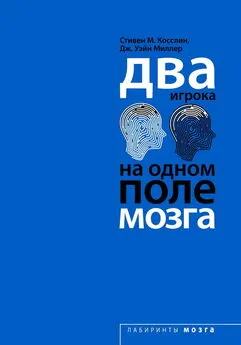Стивен Косслин - Два игрока на одном поле мозга
- Название:Два игрока на одном поле мозга
- Автор:
- Жанр:
- Издательство:Эксмо
- Год:2016
- Город:Москва
- ISBN:978-5-699-83611-6
- Рейтинг:
- Избранное:Добавить в избранное
-
Отзывы:
-
Ваша оценка:
Стивен Косслин - Два игрока на одном поле мозга краткое содержание
Настал золотой век книг о мозге. Люди стремятся, наконец, разобраться во внутренних процессах своей нервной системы. В данной книге присутствует интрига и научная сенсация — разрушенный миф о делении мозга на правое и левое полушарие. С помощью этой книги человек может расширить свое представление о работе мозга и определить собственную модель поведения.
Два игрока на одном поле мозга - читать онлайн бесплатно полную версию (весь текст целиком)
Интервал:
Закладка:
Collice, Massimo, Rosa Collice, and Alessandro Riva. Who Discovered the Sylvian Fissure? // Neurosurgery 63 (2008). P. 623-628.
Goodale, Melvyn A., and A. David Milner. Separate Visual Pathways for Perception and Action // Trends in Neurosciences 15 (1992). P. 20-25.
Lehky, Sidney R„ Xinmiao Peng, Carrie J. McAdams and Anne B. Sereno. Spatial Modulation of Primate Inferotemporal Responses by Eye Position. PLoS ONE 3(10): e3492. doi:10.1371 /journal. pone.0003492.
MacLean, Paul D. The Triune Brain in Evolution: Role in Paleocer-ebral Functions. New York: Plenum Press, 1990.
Sereno, Anne B., and Silvia C. Amador. Attention and Memory-Related Responses of Neurons in the Lateral Intraparietal Area During Spatial and Shape-Delayed Match-to-Sample Tasks // Journal of Neurophysiology, 95 (2006). P. 1078-1098.
Sylvius, Franciscus. Disputationem Medicarum, 1663.
Aginsky, Vlada, Catherine Harris, Ronald A. Rensink and Jack Beusmans. Two Strategies for Learning a Route in a Driving Simulator // Journal of Environmental Psychology 17 (1997). P. 317-331.
Blazhenkova, Olesya, Maria Kozhevnikov, and Michael A. Motes. Object-Spatial Imagery: A New Self-Report Imagery Questionnaire // Applied Cognitive Psychology 20 (2006). P. 239-263.
Blazhenkova, Olesya, and Maria Kozhevnikov. The New Object-Spatial-Verbal Cognitive Style Model: Theory and Measurement // Applied Cognitive Psychology 23 (2009). P. 638-663. Visual-Object Ability: A New Dimension of Nonverbal Intelligence // Cognition 117 (2010). P. 276-301.
Blazhenkova, Olesya, Maria Kozhevnikov and Michael Becker. Object-Spatial Imagery and Verbal Cognitive Styles in Children and Adolescents // Learning and Individual Differences 21 (2011). P. 281-287.
Ekstrom, Ruth B., John W. French and Harry H. Harman. Manual for Kit of Factor Referenced Cognitive Tests. Princeton, NJ: Educational Testing Service, 1976.
Kahneman, Daniel. Thinking, Fast and Slow. New York: Farrar, Straus Sc Giroux, 2011.
Kosslyn, Stephen M., William L. Thompson and Giorgio Ganis. The Case for Mental Imagery. New York: Oxford University Press, 2006.
Kozhevnikov, Maria, Mary Hegarty and Richard E. Mayer. Revising the Visualizer-Verbalizer Dimension: Evidence for Two Types of Visualizers // Cognition and Instruction 20 (2002). P. 47-77.
Kozhevnikov, Maria, Stephen M. Kosslyn and Jennifer Shephard. Spatial Versus Object Visualizers: A New Characterization of Cognitive Style // Memory and Cognition 33 (2005). P. 710-726.
Levine, David N., Joshua Warach and Martha J. Farah. Two Visual Systems in Mental Imagery: Dissociation of What and Where in Imagery Disorders Due to Bilateral Posterior Cerebral Lesions // Neurology 35 (1985). P. 1010-1018.
Motes, Michael A., Rafael Malach and Maria Kozhevnikov. Object-Processing Neural Efficiency Differentiates Object from Spatial Visualizers // NeuroReport 19 (2008). P. 1727-1731.
Rouw, Romke, Stephen M. Kosslyn, and Ronald Hamel. Detecting High-Level and Low-Level Properties in Visual Images and Visual Percepts //Cognition 63 (1997). P. 209-26.
Shepard, Roger N., and Jacqueline Metzler. Mental Rotation of Three-Dimensional Objects // Science 191 (1971). P. 952-954.
Woolley, Anita W., J. Richard Hackman, Thomas E. Jerde, Christopher F. Chabris, Sean L. Bennett, and Stephen M. Kosslyn. Using Brain-Based Measures to Compose Teams: How Individual Capabilities and Team Collaboration Strategies Jointly Shape Performance // Social Neuroscience 2 (2007). P. 96-105.
Roger W. Sperry and His Work Bogen, Joseph E. The Neurosurgeons Interest in the Corpus Callosum // In A History of Neurosurgery: In Its Scientific and Professional Contexts, edited by S. H. Greenblatt, 489-498. Stuttgart: Thieme, 1997.
Joseph E. Bogen //In The History of Neuroscience in Autobiography, vol. 5, edited by L. R. Squire. P. 47-122. Amsterdam: Elsevier, 2006.
Bogen, Joseph E., E. D. Fisher, and P. J. Vogel. Cerebral Commissurotomy: A Second Case Report // Journal of the American Medical Association 194 (1965). P. 1328-1329.
Gazzaniga, Michael S., Joseph E. Bogen and Roger W. Sperry. Some Functional Aspects of Sectioning the Cerebral Commissures in Man // Proceedings of the National Academy of Sciences 48 (1962). P. 1765-69.
Laterality Effects in Somesthesis Following Cerebral Commissurotomy in Man // Neurospychologia 1 (1963). P. 209-215. Observations on Visual Perception After Disconnexion of the Cerebral Hemispheres in Man // Brain 88 (1965). P. 221-236.
Gordon, H. W, Joseph E. Bogen, and Roger W. Sperry. Absence of Deconnexion Syndrome in Two Patients with Partial Section of the Neocommisures // Brain 94 (1971). P. 327-336.
Slade, Margot and Eva Hoffman. Brainwork Is Rewarding Work // New York Times, October 11, 1981.
Sperry, Roger W. (1961). Cerebral Organization and Behavior: The Split Brain Behaves in Many Respects Like Two Separate Brains, Providing New Research Possibilities // Science 133 (1961). P. 1749-1757.
Brain Bisection and Mechanisms of Consciousness // In Brain and Conscious Experience: Study Week September 28 to October 4, 1964, of the Pontificia Academia Scientiarum in Rome, edited by J. C. Eccles. P. 298-313. New York: Springer Verlag, 1965.
Brain Research: Some Head-Splitting Implications // The Voice 15 (1965). P. 11-16. Lateral Specialization in the Surgically Separated Hemispheres // In Third Neurosciences Study Program, edited by F. Schmitt and F. Worden. P. 5-19. Cambridge, MA: MIT Press, 1974.
Mind-Brain Interaction: Mentalism, Yes; Dualism, No // Neuroscience 5, no. 2 (1980). P. 195-206. Some Effects of Disconnecting the Cerebral Hemispheres // Nobel Lecture, Nobel Prize in Physiology or Medicine 1981, www.nobelprize.org /nobel prizes /medicine /laureates /1981 /sperry-lecture_en.html #.
Science and Moral Priority: Merging Mind, Brain and Human Values // Convergence, vol. 4 (Ser. ed. Ruth Anshen). New York: Columbia University Press, 1982.
Consciousness, Personal Identity and the Divided Brain // Neu-ropsychologia 22 (1984). P. 661-73. Sperry, Roger W., and Michael S. Gazzaniga. Language Following Surgical Disconnection of the Hemispheres // In Brain Mechanisms Underlying Speech and Language, edited by D. Millikan. P. 108-121. New York: Grune & Stratton, 1967.
Origins of the Left, Right Theory Goleman, Daniel. Split-Brain Psychology-Fad of the Year // Psychology Today 11 (1977). P. 88-90.
Mitzberg, Henry. Planning on the Left Side and Managing on the Right // Harvard Business Review 54 (1976). P. 49-58.
Life Magazine began publishing its dramatically illustrated five-part series about the brain on October 1, 1971.
Ornstein, Robert E. The Psychology of Consciousness. San Francisco: W. H. Freeman & Company, 1972.
Time, Hemispherical Thinker, about Robert E. Ornstein, July 8, 1974.
Pines, Maya. We Are Left-Brained or Right-Brained; Two Astonishingly Different Persons Inhabit Our Heads // New York Times Magazine, September 9, 1973.
Brain Myths and Urban Legends Harnad, Stevan and Horst D. Stek-lis. Comment on J. Paredes and M. Hepburns The Split Brain and the Culture-and-Cognition Paradox // Current Anthropology 17 (1976). P. 320-322.
Flines, Terence. Left Brain /Right Brain Mythology and Implications for Management and Training // Academy of Management Review 12 (1987). P. 600-606.
Milner, Brenda. Interhemispheric Differences in the Localization of Psychological Processes in Man // British Medical Bulletin 27 (1971). P. 272-277.
Ornstein, Robert E. The Right Mind: Making Sense of the Hemispheres. New York: Harcourt Brace & Company, 1997.
Pietschnig, Jakob, Martin Voracek and Anton K. Formann. Mozart Effect-Shmozart Effect: A Meta-Analysis // Intelligence 38 (2009). P. 314-323.
Pink, Daniel H. A Whole New Mind: Moving from the Information Age to the Conceptual Age. New York: Riverhead, 2005.
Wieder, Charles G. The Left-Brain /Right-Brain Model of Mind: Ancient Myth in Modern Garb // Visual Arts Research 10 (1984). P. 66-72.
General Background Kosslyn, Stephen M. and Olivier Koenig. Wet Mind: The New Cognitive Neuroscience. New York: Free Press, 1992 and 1995.
Springer, Sally P., and Georg Deutsch. Left Brain, Right Brain: Perspectives from Cognitive Neuroscience. New York: W. H. Freeman and Company, 1981 and 1998.
Gregory, Richard L. «The Brain as an Engineering Problem». In Current Problems in Animal Behaviour, edited by W. H. Thorpe and O. L. Zangwill. Cambridge: Cambridge University Press, 1961.
Macmillan, Malcolm. An Odd Kind of Fame: Stories of Phineas Gage. Cambridge, MA: MIT Press, 2002.
Biederman, Irving, and Maggie M. Shiffrar. Sexing Day-Old Chicks: A Case Study and Expert Systems Analysis of a Difficult Perceptual-Learning Task // Journal of Experimental Psychology: Learning, Memory and Cognition 13 (1987). P. 640-645.
Bouchard, Thomas J., Jr. Genetic Influence on Human Psychological Traits: A Survey // Current Directions in Psychological Science 13 (2004). P. 148-151.
Ericsson, K. Anders, William G. Chase and Steve Faloon. Acquisition of a Memory Skill // Science 208 (1980). P. 1181-1182.
Kagan, Jerome, and Nancy Snidman. Early Childhood Predictors of Adult Anxiety Disorders // Biological Psychiatry 46 (1999). P. 1536-1541.
Kagan, Jerome. Galen’s Prophecy: Temperament in Human Nature. New York: Basic Books, 1994.
Plomin, Robert, John C. DeFries, Valerie S. ICnopik and Jenae M. Neiderhiser. Behavioral Genetics, 6th ed. New York: Worth Publishing, 2012.
McManis, Mark H., Jerome Kagan, Nancy C. Snidman and Sue A. Woodward. EEG Asymmetry, Power, and Temperament in Children // Developmental Psychobiology 41 (2002). P. 169-177.
Saudino, Kim J. Behavioral Genetics and Child Temperament // Journal of Developmental and Behavioral Pediatrics 26 (2005). P. 214-223.
Biederman, Irving and Maggie M. ShifFrar. Sexing Day-Old Chicks: A Case Study and Expert Systems Analysis of a Difficult Perceptual-Learning Task // Journal of Experimental Psychology: Learning, Memory, and Cognition 13 (1987). P. 640-645.
Bouchard, Thomas J., Jr. Genetic Influence on Human Psychological Traits: A Survey // Current Directions in Psychological Science 13 (2004). P. 148-151.
Committee on Support for Thinking Spatially. Learning to Think Spatially: GIS as a Support System in the K-12 Curriculum. Washington, DC: National Academies Press, 2006.
Ericsson, K. Anders, William G. Chase and Steve Faloon. Acquisition of a Memory Skill // Science 208 (1980). P. 1181-1182.
Ericsson, K. Anders, V. Patel and Walter Kintsch. How Experts’ Adaptations to Representative Task Demands Account for the Expertise in Memory Recall: Comment on Vicente and Wang (1998) // Psychological Review 107 (2000). P. 578-592.
Hu, Yi, К. Anders Ericsson, Dan Yang and Chao Lu. Superior Self-Paced Memorization of Digits in Spite of a Normal Digit Span: The Structure of a Memorises Skill // Journal of Experimental Psychology 35 (2009). P. 1426-4742.
Kagan, Jerome. Galen’s Prophecy: Temperament in Human Nature. New York: Basic Books, 1994.
Kagan, Jerome, and Nancy Snidman. Early Childhood Predictors of Adult Anxiety Disorders // Biological Psychiatry 46 (1999). P. 1536-1541.
Kagan, Jerome, Nancy Snidman, Marcel Zentner and Eric Peterson. Infant Temperament and Anxious Symptoms in School Age Children // Developmental Psychopathology 11 (1999). P. 209-224. McManis, Mark H., Jerome Kagan, Nancy C. Snidman and Sue A. Woodward. EEG Asymmetry, Power, and Temperament in Children // Developmental Psychobiology 41 (2002). P. 169-177. Saudino, Kim J. Behavioral Genetics and Child Temperament // Journal of Developmental and Behavioral Pediatrics 26 (2005). P. 214-223.
Читать дальшеИнтервал:
Закладка:







